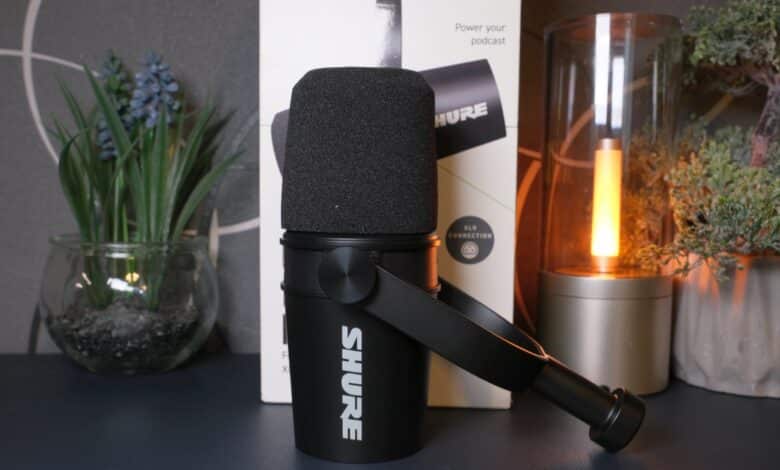
Manufacturer Shure has been one of the most renowned names in audio technology and microphones since its founding in 1925, and now also offers a fairly wide range of headphones like the Shure Aonic Free (our review). The SM7b XLR microphone in particular enjoys almost cult status, especially among podcasters and content creators. The MV7X analog XLR microphone is considerably less expensive. How good it sounds and whether the purchase is worthwhile, clarifies our Shure MV7X test.
Technical data
| Microphone type | Dynamic (Moving Coil) |
| Connection | XLR (3-pin) |
| Impedance | 252 Ohm |
| Sensitivity | 55 dBV/Pa (1 V/Pa at 1 kHz) |
| Directivity | Cardioid (uni-directional) |
| Frequency range | 50 Hz – 16,000 Hz |
| Dimensions (height x diameter) | 155 mm x 55 mm |
| Weight | 552 grams |
| Price | € 169.00 * |
Shure MV7X review: design and scope of delivery
- Sleek, high-quality design
- Rugged metal construction
- Disappointing scope of delivery without accessories
The Shure MV7X comes in a fairly inconspicuous white box with black paint. The scope of delivery then presents itself similarly inconspicuous, because you do not linger long with accessories. You will only find the microphone itself in the box, along with the pop filter. Apart from a few short notes and safety information, that’s it for the meager scope.
As far as the design is concerned, however, it looks a lot better. Visually, the MV7X is based on its almost legendary indirect predecessor SM7b and the direct predecessor MV7. This means that you get a very high-quality, metal XLR microphone that comes in a black color scheme with a white printed manufacturer logo that screams “professional” loudly.
155 millimeters is the good piece long, 55 mm it measures around diameter. And with a weight of 552 grams, it is more in the middle range – after all, it weighs over 100 grams more than, for example, an Elgato Wave DX (our review), which is also made of metal and is similar in size.
The foam pop filter can be removed to reveal the cardioid microphone underneath, which sits under a sturdy metal grille. Due to the purely analog character, you won’t find any buttons or controls on the microphone. But there is a 3-pin XLR connector on the bottom.
The design is very similar to the FDUCE SL40, which we tested in July 2022. Who said microphone was modeled after is obvious in regards to the Shure SM7b.
Well, be that as it may. Just like the other Shure mics aimed at podcasters and content creators, but also singers, it comes with a holding stand, also made of metal, to which you can attach the mic to stands or mic arms using a 3/8- or 5/8-inch thread.
Commissioning and field test
- Quickly ready for use
- Does not require, as a dynamic microphone, 48V phantom power
-
Voice isolation technology and integrated shock mount
In practice, the Shure MV7X is quickly ready for use. Cable in, connect to the audio interface and you’re ready to go. It’s important to note that this model is a fully analog and, more importantly, dynamic XLR microphone.
So, unlike a condenser microphone, a 48V phantom power is not required, which of course increases the compatibility of the MV7X. However, you need more gain or power to achieve the same signal strength or volume.
Without going into great technical detail, dynamic microphones are usually more robust and simpler, but at least in most cases they offer a lower dynamic range. On the other hand, simplicity usually allows for lower prices.
The Shure MV7X also has the advantage that it filters out ambient noise more (or picks it up less) and you should ideally speak directly into the microphone from a short distance. In addition, the device has a special voice isolation technology that is supposed to additionally block out background noise.
So, the advantage lies mainly in the simplicity, which you want to combine with the highly praised sound of the SM7b. At half the price. Compared to its direct predecessor in the form of the MV7, the X has no additional USB port and relies solely on the XLR connector.

While the MV7 offers significantly more options, not least thanks to the additional USB port, digital processing and controls on the microphone itself, the MV7X focuses on the essentials. At least, you could say that.
Recording Quality of the Shure MV7X
- Dynamic microphone
- Comparatively insensitive to plosives and s-sounds
- Sound on par with the SM7b
The Shure MV7X is a dynamic microphone with a uni-directional pickup pattern (also known as cardioid). It covers a frequency range of 50 Hz to 16,000 Hz and achieves an impedance of 252 ohms. The sensitivity of -55 dBV/Pa at 1 kHz can also be considered a good standard.
So everything sounds quite good at first, but not very impressive. However, the result that finally comes out of the speakers is all the more impressive. And that even in anything but ideal recording scenarios with loud environments and without additional damping.

In the Shure MV7X test, the microphone steps stoutly into action and scores with a detailed, warm and dynamic voice reproduction. At the same time, it proves to be quite insensitive to plosive sounds or sibilants, which is due to the dynamic structure and the successful pop filter.
Pleeway in positioning
The amount of bass in the voice can be conveniently controlled by the distance to the microphone. The closer you are to it, the bassier the voice becomes. I also like the way the microphone handles movements. You do not always have to speak frontally into the microphone. In fact, I like the sound a bit better when you place the MV7X at a slight angle to your mouth.
In general, the sound is a bit louder and more detailed than in the case of the MV7 when powered via XLR. It doesn’t quite measure up to the iconic SM7b – but that should be obvious considering the significantly lower price. But the differences turn out to be smaller than first thought.
The device is particularly well suited for recording voices, i.e. for podcasts, dubbing videos or vocals. It copes very well even with very loud sounds, without any distortion.
By removing the windscreen, you can also improve the clarity of the highs a bit, but this makes the microphone a bit more susceptible to plosives or sharp S sounds. Depending on the tone of your voice, this may make sense, but you should try it out for yourself.
If you believe other tests, it is supposed to be quite suitable for recording instruments, which I can not verify due to lack of talent (or appropriate instruments). However, the manufacturer advertises the device itself as a podcast microphone and I think there are clearly better solutions for recording instruments.
Shure-typically, the MV7X with its characteristic is thus suitable primarily for voices that have a not quite so deep fundamental tone. This is where the warm, somewhat deeper mix comes into its own. For already deep or bassy voices, however, the sound can sometimes become a bit growly and muffled.
Shure MV7X review: conclusion
With the Shure MV7X, the manufacturer offers a simple and at the same time high-quality dynamic XLR microphone that hardly has to hide behind the legendary SM7b in terms of its sonic properties.
For the price of less than 200 euros, you get an extremely robust and high-quality microphone that copes amazingly well with plosives and s-sounds and is extremely well suited for podcasts, broadcasting and voice recordings of any kind.
Another positive aspect is the analog design in combination with the dynamic character, which makes it possible to use it without 48V phantom power and therefore expands the application possibilities.
On the other hand, you also have to do without any features beyond the basics. As is typical for the manufacturer, the MV7X is also particularly suitable for not quite so deep, bassy voices and brings them to bear excellently. What remains in the end is a sonically convincing XLR microphone that lacks any special features or accessories, but makes up for it (at least in part) with its characteristics and can thus keep up very well with more expensive competitors.
However, you have to decide for yourself whether the extra sound quality is worth the extra price compared to a 100-euro microphone. Especially at the price, which has dropped in the meantime, the MV7X is absolutely worth a recommendation and positions itself excellently with the MV7 (approx. 254 euros) and professional Shure SM7b (approx. 379 euros), which are almost identical in terms of sound but can also be controlled via USB.
Shure MV7X
Workmanship
Recording quality
Features
Value for money
90/100
Purist dynamic XLR microphone at a quite fair price, which scores especially with its high-quality workmanship and excellent sound.



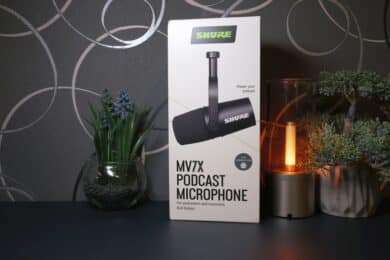


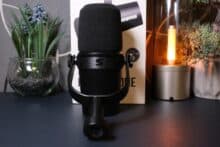
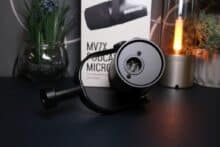

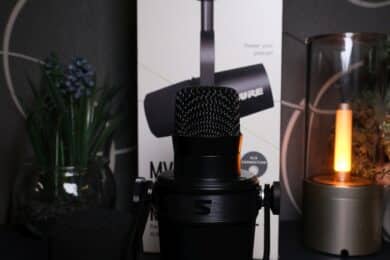
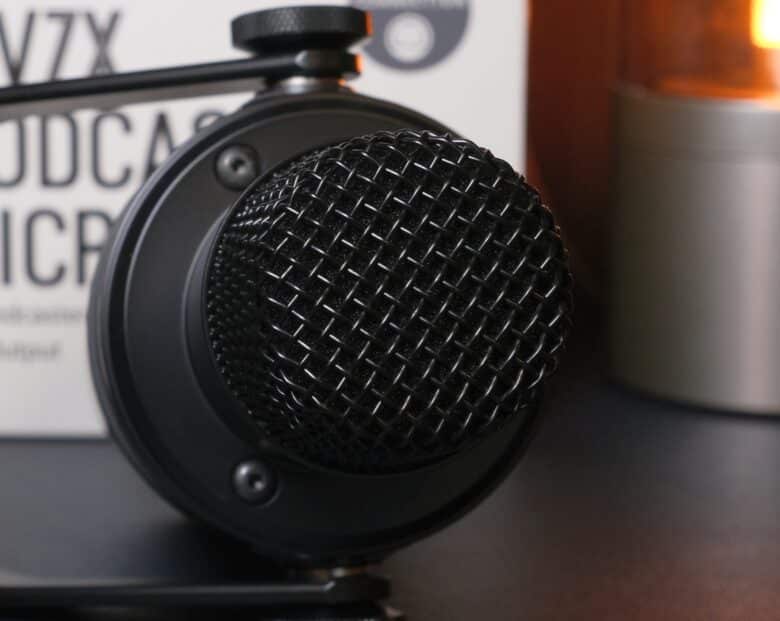


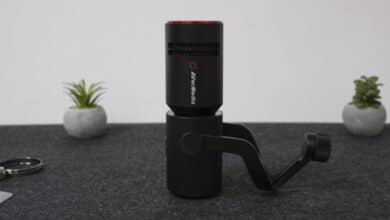


No replies yet
Neue Antworten laden...
Gehört zum Inventar
Beteilige dich an der Diskussion in der Basic Tutorials Community →